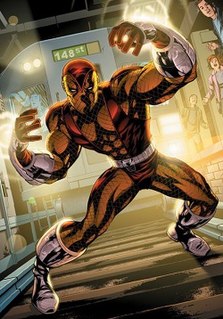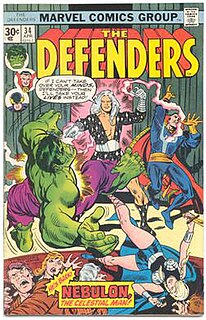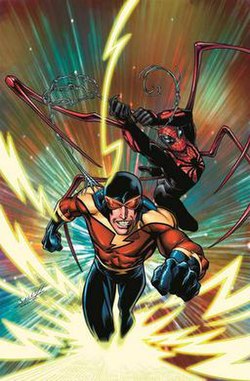
Whizzer is the name of several fictional characters appearing in American comic books published by Marvel Comics. The first character debuted during the Golden Age in USA Comics #1, and was reintroduced in Giant-Size Avengers #1. A second villainous version debuts during the Silver Age in The Avengers #69, and a second heroic version debuting in The Avengers #85.

The Squadron Supreme is a fictional superhero team appearing in American comic books published by Marvel Comics, of which there are several notable alternate versions. The original team was created by Roy Thomas and John Buscema, derived from the previously created supervillain team Squadron Sinister.

MacDonald "Mac" Gargan is a fictional supervillain appearing in American comic books published by Marvel Comics. The character is usually depicted as an adversary of the superhero Spider-Man. Created by Stan Lee and Steve Ditko, he first appeared in The Amazing Spider-Man #19 as a private investigator hired by J. Jonah Jameson to learn how Peter Parker took pictures of Spider-Man. In the following issue, Jameson decided to turn Gargan into a deadly adversary for Spider-Man through a barely-tested procedure, which left Gargan with an unremovable scorpion-themed armor and the predatory instincts of the arachnid. Driven insane by his mutation, Gargan instead turned to a life of crime as the Scorpion, and went on to menace both Spider-Man and Jameson, whom he held responsible for his transformation. Since then, Gargan has also served as the third host of the Venom symbiote, and a member of the Dark Avengers as Spider-Man, but eventually returned to his Scorpion alias.

The Shocker is a supervillain appearing in American comic books published by Marvel Comics. He is usually depicted as an enemy of the superhero Spider-Man, and belongs to the collective of adversaries that make up his rogues' gallery. Created by writer Stan Lee and artist John Romita Sr, the character debuted in The Amazing Spider-Man #46.

Hydro-Man is a supervillain appearing in American comic books published by Marvel Comics as an enemy of the superhero Spider-Man. Once an ordinary crewman, Morris Bench was accidentally knocked overboard while stationed on his ship during a battle between Spider-Man and Namor, and fell into the ocean, where a powerful experimental generator was being tested. This led to his transformation into Hydro-Man who, blaming Spider-Man for what happened to him, turned to a life of crime while seeking revenge against the web-slinger.

Hyperion is a fictional character appearing in American comic books published by Marvel Comics, of which there are several notable versions. The original Hyperion made his debut in The Avengers #69, created by writer Roy Thomas and artist Sal Buscema. The alternate versions are each from a different dimension of the Marvel Multiverse, and consist of both heroes and villains. Thomas says that the character was intended as a pastiche of DC's iconic hero Superman.

Nighthawk is the name of several fictional characters appearing in American comic books published by Marvel Comics. There have been six versions of the character: a supervillain-turned-superhero from the mainstream Marvel Universe continuity, Kyle Richmond, who belonged to the team Squadron Sinister; and five from alternate universes, who belonged to various incarnations of the team Squadron Supreme, including Neal Richmond and Jackson "Jack" Norris.

The Elders of the Universe are a group of supervillains appearing in American comic books published by Marvel Comics. The Collector was the first Elder to appear, and featured in The Avengers #28, but the idea that he was a member of a group known as the Elders was not introduced until The Avengers #174.

The Grandmaster is a fictional character appearing in American comic books published by Marvel Comics. The character first appeared in The Avengers #69. The Grandmaster is one of the ageless Elders of the Universe and has mastered most civilizations' games of skill and chance. Different media appearances depict him as the brother of the Collector.

The Thunderbolts are a fictional superhero team appearing in American comic books published by Marvel Comics. The team consists mostly of reformed supervillains.

Doctor Spectrum is the name of several fictional characters appearing in American comic books published by Marvel Comics. There have been five versions of the character to date—three supervillains from the mainstream Marvel Universe belonging to the team Squadron Sinister (Earth-616) and two heroes from different alternate universes. The two heroes each belong to a version of the team Squadron Supreme, the Squadron Supreme of Earth-712 and the Squadron Supreme of Earth-31916 respectively). Doctor Spectrum is a pastiche of DC's Green Lantern.

Abner Ronald Jenkins, also known as the Beetle, MACH-1, MACH-2, MACH-3, MACH-IV, MACH-V, MACH-VII and MACH-X, is a fictional character appearing in American comic books published by Marvel Comics. He made his debut as the Beetle in Strange Tales #123 and later first appeared as MACH-1 in Incredible Hulk #449 during the Thunderbolts' debut.

Erik Josten, also known as Power Man, Smuggler, Goliath and Atlas, is a fictional character appearing in American comic books published by Marvel Comics. The character has been a prominent member of both the Masters of Evil and the Thunderbolts.

Boomerang is a fictional character appearing in American comic books published by Marvel Comics. He has been a member of several prominent supervillain teams and clashed with several heroes throughout his career, most notably Spider-Man.

Tiger Shark is a fictional character, a supervillain appearing in American comic books published by Marvel Comics.

The Squadron Sinister is a supervillain team appearing in American comic books published by Marvel Comics. The Squadron Sinister first appeared in the final panel of The Avengers #69, created by Roy Thomas and Sal Buscema. The team is a pastiche of DC's Justice League.
The Sinister Syndicate is a group of supervillains appearing in American comic books published by Marvel Comics. The characters serve as a collection of lesser-known Spider-Man villains. The group was the focus of the 1991 Deadly Foes of Spider-Man mini-series.

The Beetle is the name used by multiple fictional characters appearing in American comic books published by Marvel Comics. It is also the name of three versions of high tech armor used by seven separate characters.

Nebulon is a fictional character appearing in American comic books published by Marvel Comics.

The Whizzer is a fictional superhero appearing in American comic books published by Marvel Comics. He first appeared during the period that fans and historians call the Golden Age of Comic Books.




















